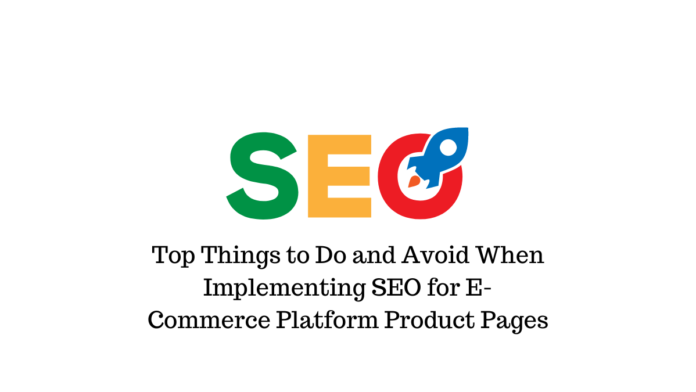Last updated - October 17, 2022
With e-commerce expected to dominate retail in the coming years, more and more players are getting into the game, even if they have established themselves in the brick-and-mortar business. With every e-commerce business wanting to grab a larger slice of the pie, you must ensure you are implementing the right strategy for SEO for E-Commerce. It is even more critical to get the SEO strategy right, given the prohibitive costs and dwindling returns on investments in advertising.
What You Need To Do To Make SEO for E-Commerce Product Pages Deliver


Tweak your keyword strategy: Optimization of product pages is only possible with proper keyword research. You must use topics focused on products for which users are searching. Instead of obsessing over volumes, you will do better to think about relevance and conversion potential. You must not hesitate to use data from any other source like paid search in your keyword and content research. You can also profit from incorporating compelling ad copy with high CTRs into the Meta descriptions. You need to ensure you optimize the landing pages for easy conversion because users on product pages have high transactional intent.
Optimize titles and Meta descriptions: Title tags and Meta descriptions play a pivotal role in product page optimization. You need to ensure that you do not forget to include details like the brand names of the products, the product name, and product details like dimensions, power rating, weight, model number, etc.
Use structured data to mark up product pages: You can help your brand appear in Google’s rich snippets by using the correct structured data. It means you must make sure all product pages have the necessary product schema together with the review schema to drive more impressions and clicks. You will find your CTR and sales improving.
Include helpful and clear FAQs: High-quality content is one of the most important considerations in achieving a high rank in the SERPs. If users do not find value in your content, they will abandon your website, which apart from the lost conversion opportunities, also hurts your SEO for E-Commerce due to the high bounce rate. A FAQ page section is useful since it helps users obtain the information they need without getting in touch with the customer helpdesk. Relying on user-generated content to support product pages can be a mistake as the information is not structured and is difficult to extract by users.
Create distinctive product and Meta descriptions: Many e-commerce sites use the same product description for all products because they do not want to take the extra effort of creating unique ones for each product. However, the lazy route, even if convenient, means you lose out on many opportunities for better visibility in the SERPs. You can include both branded and non-branded keywords in their description to improve your SEO for E-Commerce. In addition to better rankings, users will benefit from more relevant and helpful information that encourages them to click and visit your product page.
Share customer reviews and testimonials: Research reveals that product pages with customer reviews and feedback convert more than 52% better than pages without such content. When customers are trying to decide on a purchase, it is commonplace to seek validation by reading product reviews of real customers. For this reason, you must always encourage customers to share their experiences, tell how they have solved issues they faced, and suggest product improvement. Authentic reviews by real customers contain valuable information that other customers can base their decision on, but used strategically can help influence people if the reviewer is someone people know and trust. According to Search Engine Land, customer reviews provide Google with additional contextual content vital for sustained high search rankings.
What to Avoid When Implementing SEO for E-Commerce Product Pages


Manufacturer’s product descriptions: The trouble with using the product descriptions provided by manufacturers on their websites is they are not written well. Not only do the descriptions lack the details customers typically want, but also they do not have the optimization that makes them valuable to search engines. Even though creating informative and engaging descriptions can take a lot of effort, it is well worth it because the more detailed the information is better the search rankings and the chances of conversions. Creating unique content also means no chance of Google penalizing you for duplicating content.
Switch off-season pages after the peak season: Killing the seasonal pages once the busy season is over may seem sensible, but you will have to struggle again the following year to regain the authority required by the website to rank well for seasonal sales. It is best not to kill the seasonal product pages if it has built up traffic, sales, and rankings over time. Keep it alive and update it when the season comes.
Remove out-of-stock pages: It is not unusual for e-commerce platforms to run out of stock, particularly, if there has been a successful sales promotion. You must resist the temptation to kill the URL if the product is temporarily unavailable to avoid losing the domain authority that the page would have built up with its earlier traffic and ranking. In terms of SEO for E-Commerce, it pays off better to keep the pages live and fill them with links to other but relevant products until you can bring back the stock-out items.
Missing or weak calls to action: Despite being present on a fully functional e-commerce platform, many brands report less than satisfactory conversions. A common reason is the necessary CTAs prompting conversions are either missing or do not have the required effectiveness. The principal task of product pages is to drive sales, and you must make it easy and fulfilling for users to purchase products. If they are not convinced, they will go to some other competitor.
Conclusion
Building a successful e-commerce platform depends principally on two things. One is your ability to include all the functions and features potential customers typically look for in online shopping sites, and the other is a commitment to serving the interests of customers by offering brands with high credibility and providing customers with adequate information with structured content, FAQ pages, and customer reviews. You also need to stay clear of common mistakes that prevent customers from visiting your site and converting into paying customers.











